#also the meme it's not mine the watermark is there you can search the name there are cursed things there tho
Text

wait he's innocent it was the rats
#14dwy violet#14dwy ren#14dwy oc#is this considered a shitpost#im not putting the main tag in this thing but maybe Violet nation is starving so im tagging that don't mind Ren exploding he's ok#he's ok and got cheese (i don't even know if he likes cheese)#would a character do this -> no -> would it be funny it they did it -> yes -> that's enough for me#i don't even remember what made me do this or how my brain connected the dots (what dots bro???wtfff)#okback to my enclosure 🍖#ishouuld have a big sign everywhere that says NOTHING I DO IS CANON#Violet if she didn't get nerfed for the sake of the narrative /silly#do you see the vision <- totally not thinking straight#sorry i made you explode Ren i love you a lot#also the meme it's not mine the watermark is there you can search the name there are cursed things there tho#i was lazy to change the text that's why it says spongebob but i thought it was funny so i left it there#what's the tag limit hello hiiii:33 heyyy:3:3
36 notes
·
View notes
Text
How to recognize art theft/uncredited reposting!
Learn these signs so that when you think you see them, you can make sure an artwork you like was actually posted by the original artist.
Fuzzy quality. Any amount of fuzziness. The kind of fuzzy that memes typically are. Artists will do what they can to make sure their posted art looks as crisp as tumblr or wherever else will allow. They spent time looking at and making that piece without the fuzz and aren’t going to rest easy if their work looks like a damn meme.
Source listed. It’s the easiest thing to see. Is there a separate name and link in the caption? “This isn’t mine, I don’t know who drew it, I just like it a lot” is NOT acceptable. EVER. Even if an artist allows reposts.
If there’s a watermark or signature on the art, does it match up with the url of the poster at all? Or the name they claim in their blog description? No? It probably ain’t theirs.
Is it tagged with anything like #my art? Sure, thieves can use this so more double checking is required, but if it’s not tagged like this the chance it’s not the original is high.
Just check out the blog. Is there more art in this style? Is there a bunch of other art spammed in obviously different styles? If it’s considerably impressive art, do the lower note counts make sense? These types of blogs are unfortunately COMMON so be wary of them.
This might seem like a lot, but typically it should take less than 10 seconds to recognize a stolen or reposted work. It really isn’t hard to have an eye for this. Even if it was hard, artists deserve proper credit, respect, and therefore the effort. AND if possible, reporting/letting original artists know when their work is being reposted without permission is also important.
If you absolutely must reblog a pretty artwork that was stolen or uncredited, and the actual artist’s url tacked onto the art isn’t coming up, USE A REVERSE IMAGE SEARCH. Chances are you’ll be able to dig up the origin.
5 notes
·
View notes
Text
‘Building the Cockchain:’ How NSFW Artists Are Shaping the Future of NFTs
A few months ago, Jen Stein entered a room in the voice chat app Clubhouse called "Decentralized Systems," looking for conversations about censorship solutions on social media. She creates sculptural art using colorful dildos as the medium, and had recently been kicked off of Instagram. To her surprise, she found a group of people in the middle of a conversation about cryptocurrency.
"I was like, 'I'm so sorry, I think I came to the wrong room… I did not realize this was about Bitcoin,'" she told me. "I'd heard about Bitcoin like once before, through all these memes about money… I hate money, I hate capitalism, I don't care," she recalled. But the people in that room told her to stay and learn about non-fungible tokens, or NFTs. "It just opened my eyes to what this technology could actually do."
Non-fungible tokens, or NFTs, are visual, cryptographic assets on the blockchain that are unique from one another and can represent ownership of an associated digital item. Stein listed images of her sculptures on Rarible, a digital marketplace for NFTs, and calls it "building the cockchain." She's since personally taught more than 100 people the ins and outs of NFTs and cryptocurrency, and written guides on how to get into it. "I've never been more inspired by anything in a really long time—especially after this year, I was feeling very just not hopeful about the world," she said.
NFTs have gained traction in the world of art and collectors' items. Each token points to a digital work in some way, and because they're minted on the blockchain, they're harder to defraud and impossible to duplicate. This means one can track where they're transferred and sold. Unlike cryptocurrencies like Bitcoin or Ethereum, you can't pay for things with them like money; they're more like receipts than dollar bills. It would be like trying to buy a coffee with a printed picture of Nyan Cat. But they're useful for artists who want to build a community of collectors, and invest in art that could increase in value over time.
NFTs have gotten a lot of attention lately, both for successes such as art sales in the millions, and for criticisms around the environmental cost of cryptocurrency mining and issues such as theft. But the technology isn't new. They've been around for years—at least as far back as Rare Pepes in 2017—and the basic idea stretches back farther, with "Colored Coins'' issued on the Bitcoin blockchain in 2012.
In the last month, several well-known artists—including rapper Azealia Banks, who sold the rights to an audio sex tape for $17,000, and Russian rock group Pussy Riot, which released a new video as series of protest-art tokens to benefit women's shelters—seem to be paving the way for works that push the boundaries way beyond Cryptokitties. There’s even an NFT-based streaming alternative to Spotify. But is the same success attainable for smaller, independent erotic artists?
THE BENEFITS
Multidisciplinary artist PolyAnnie started minting NFTs in September 2020. She does performance art, erotic physical and digital art, and is a content creator on OnlyFans. "NFTs allow me to set the conditions of my work and provide me the ability to gamify my entire body of work in ways that one day I can take my hands off the 'wheel' and let my brand run itself," she said.
To her, the benefits of getting into the NFT world include a more direct relationship with fans and those fans become investors, as well as the financial: she's made more income from crypto-art in five months than she usually would in an entire year. Now, she runs a weekly conference call that's open to anyone who wants to learn more about getting into adult NFTs.
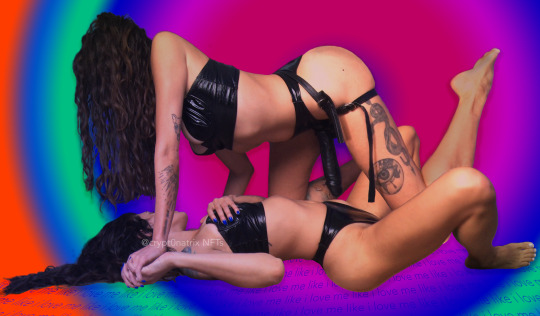
"Self-Love," by Cryptonatrix. Image courtesy Cryptonatrix
For erotic artists and sex workers, who are constantly dogged by payment processors' prudish rules and risk having their Venmo, Cashapp, and Paypal accounts closed for selling sexy content, the decentralized nature of NFTs is appealing. Unlike with these services, which are moderated by a central authority, digital receipts published to the blockchain are permanent and there will always be methods of transferring cryptocurrency without the use of middlemen who might take issue with the transaction. For some, this looks like the future of the adult industry.
Cryptoempress, a professional dancer and nude model as well as cryptocurrency enthusiast, mostly creates NFTs from her own nude photos. She saw the combination of crypto and modeling as a natural fit.
"I think the future for NFT’s, crypto-art and NSFW artists is bright, because the world is changing to a direction where nudity is not a taboo anymore," she said. "You can create nude art on the blockchain with the actual opportunity to earn money." She also likes that NFTs can bring in royalties—if someone buys her work and then resells it, she can receive the royalties she sets as a term of the sale.
"I think that NFTs are a great 'gateway drug' to bring anyone into crypto," Cryptonatrix, who works as a dominatrix, told me. "However, I imagine it will take time for adult content creators and buyers to become familiar with what’s going on in this space, just as it will take time for new adult specific NFT platforms to develop and test themselves."
THE RISKS
As excited as she was about cryptocurrency's potential for art, it took Stein a few weeks after learning about cryptocurrency to start her own wallet. "It was the PTSD of being on other platforms where [sex is] the first thing that gets regulated," she said. "Something's gonna happen with sex, sexuality and kids, or with kids money."
Even if cryptocurrency infrastructure is fairly agnostic, markets represent a possible bottleneck for content creators. Rarible's terms of use prohibit users to "publish, post, distribute or disseminate any profane, obscene, pornographic indecent or unlawful content, pictures, topic, name, material or information," for example, but at the same time, has a dedicated NSFW category. OpenSea, another listing marketplace, is more lenient. Its terms of use state that it allows the sale of NSFW content, but that content is "subject to being marked NSFW and handled differently than non-NSFW content in navigation menus and search results," and the site bans "asset names, listings and their descriptions, smart contract names, and collections including profanity, sexually explicit, or overtly sexual content." SuperRare, another marketplace, does not allow minting pornographic or obscene content—but a quick search on the platform shows that this rule is pretty loose. Foundation similarly forbids vulgar, obscene or pornographic content.
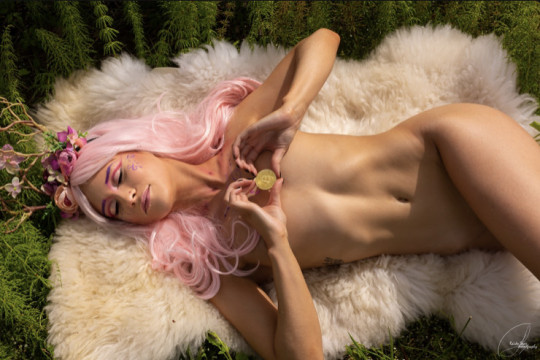
Image courtesy Cryptoempress
All of this surfaces age-old questions about what constitutes art, porn, and erotica—and what makes each of these distinct from the others. What might be considered acceptably NSFW without crossing the line into “obscene” on these platforms?
"The very notion of erotica as 'good,' clean, non-explicit representations of sexual pleasure in opposition to dirty, explicit pornographic ones is false," porn scholar Linda Williams wrote in Hard Core. "The one emphasizes desire, the other satisfaction. Depending on who is looking, both can appear dirty, perverse, or too explicit." And as pornographic legend Gloria Leonard, once put it bluntly: “The difference between porn and erotica is the lighting."
"Just as what is considered 'art' is infinitely debated and in the eyes of the beholder, what is considered inappropriate, varies greatly amongst individuals," Cryptoempress said. In these cases, the beholder is the platforms themselves.
"Obscenity" at least has a legal definition, but it's subject to jurisdiction. "What jurisdiction is the metaverse?" Stein said.
Cryptonatrix said she had one of her first NFTs removed by Rarible, without explanation. "Terms of Service are never written so clearly, which allows platforms to censor selectively," she said. "As with any social platform, there are definitely double standards in the way their ToS are applied, and in who they choose to promote. For example, a GIF of me wearing a strap-on silicone toy was removed while others sell uncensored nudes, men have minted dick pics, and there is other art involving dildos not actually being worn." There's also a double standard on platforms about erotic content when it's made by a someone who is openly a sex worker, versus someone without that stigma attached to them and their art, she said. But there's still less risk of deplatforming in crypto-art so far than there is on Facebook or Instagram.
There's also the usual security risks that anyone connecting their credit care to a relatively new platform take on: earlier this week, several users on token marketplace Nifty Gateway had thousands of dollars stolen from their accounts, because the site doesn't require two-factor authentication. And there's always the risk of copyright infringement and stolen art ending up on a marketplace—a problem pornographers have dealt with since the earliest days of putting images of sex on the internet, and one that's only expounded with the rise of independent sex work such as camming and clip sites.
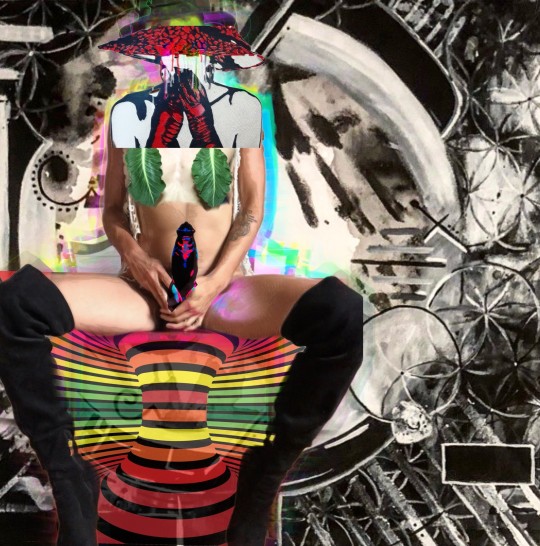
Image courtesy PolyAnnie
Some sex workers are trying to stay a step ahead by minting their own works on the blockchain before someone else can: Allie Eve Knox told Motherboard that she's been minting her works before others can, and watermarking them with a "bid now" banner that stays on the image until it's purchased, to keep people from stealing the jpeg or screenshotting it.
A complication of NFTs (and a risk for sellers) is that most tokens give the purchaser the right to do what they want with it, including reselling it. "When I shoot for a company or whatever, I sign those rights away in a contract, but here, there is no contract. There is no law. There is no regulation, aside from moderation of the site—which is hella subjective," Knox said.
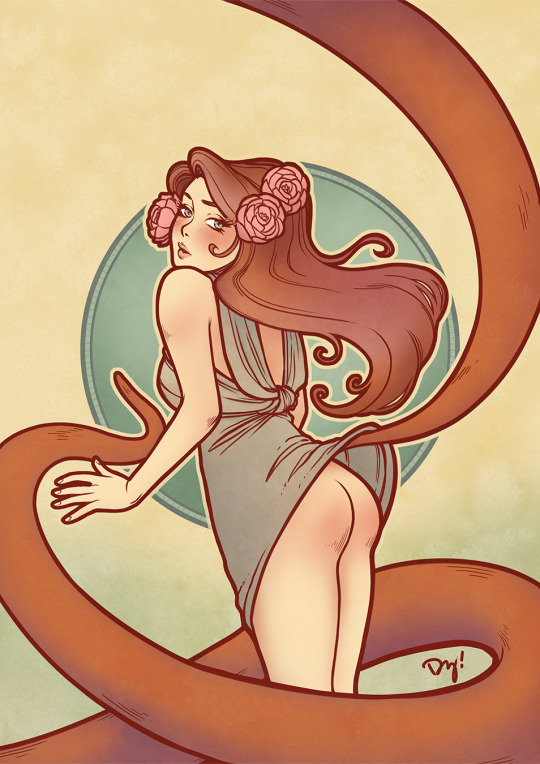
Re(Booty) by Caroline Dy. Image courtesy Caroline Dy
Stein and Cryptonatrix both brought up the fact that most marketplace platforms don't have age verification or consent agreements, for either the seller or the buyer. "I think it’s just like any new technology, in that with the endless amount of positive potential it may bring, there are also dangers that we cannot yet foresee," Cryptonatrix said. "I am moving cautiously, including with the projects that I am aligning myself with."
Some of these issues are the growing pains of a newly-popular medium, but mostly they're predictable questions within the adult content industry.
"Any fringe content will remain vulnerable to censorship as long as payment and computation hosting are in the hands of large tech companies," PolyAnnie said. "Blockchains are not evolved enough to host the content itself, only the proof of purchase and ownership. Therefore, blockchains can solve payment vulnerabilities, yet blockchains cannot address censorship in who gets hosted on the tech giant’s servers." Although there are ways to host images on the blockchain, they're very limited, and more like storing pixel art.
The NFT boom could also help illustrators who make more erotic-themed art in private expand that work into the public. Caroline Dy, who got into NFTs to supplement her income as a technical artist and game developer, creates digitally-painted portraits and pin-ups. "I'm exploring the idea of publishing more work that leans towards erotica as I believe we need to destigmatize and normalize talking about sex," Dy said.
"It’s extremely important to not get too drugged up on that 'hopium,'" Cryptonatrix said. "Neither sex work nor cryptoart is easy money, though that misconception is certainly prevalent in regards to both."
Even with the uncertainty of where this technology and art form will go, Stein said she'd still encourage anyone who's been shut out of other platforms to try making their own NFTs.
"There are so many people that have already lost their voices, and they're the ones that need this," she said. "I see this technology as a way to get voices to the people that have not been able to use them.”
‘Building the Cockchain:’ How NSFW Artists Are Shaping the Future of NFTs syndicated from https://triviaqaweb.wordpress.com/feed/
1 note
·
View note
Text
Western social media has no respect for Japanese online artists - and it’s killing online art
The visual arts have evolved to suit the most popular medium of each era. In nowadays’ case, the internet is the go-to method of sharing the fruits of one’s labour). However, as stated in that tweet thread of mine you can see if you scroll down a bit (assuming you’re viewing this post on chariot313.tumblr.com) different cultures have different attitudes towards how their customers react to their products. This include you know what fuck the formalities, I’ll just say it: The exclusively western concept of someone seeing something they like online and hitting the share button to stimulate the “Haha, upvotes go ‘brrr’!” dopamine in their smooth-ass lizard brain will be the death of online Japanese artists. Or rather, it has been already, and you would know that if you’ve ever seen an artist’s Twitter bio be in mostly Japanese save for one sentence in English; “Reprint is prohibited.”.
If you want to hear me rationalize the absurd claim I just made, feel free to click the “Keep reading” button. Otherwise, turn back now and save yourself from me possibly wasting your time.
Alright, you’ve chosen to stick with me. Just remember, you asked for this.
Introduction
Social media as a whole is based around sharing (posting, uploading, submitting, tweeting, blogging, streaming etc.) and other’s reactions to what one has shared (views, likes, subscribers, favorites, followers, upvotes, retweets, reblogs, crossposts, etc.).
However, miscommunication and culture shock due to language barriers and cultural differences is one of the many factors that can negatively affect one’s experience on social media. For example, the Japanese artist community, active on sites such as Twitter, Pixiv, NicoNico Seiga, FC2 blogs, etc.. Twitter is mostly inhabited by English-speaking users. Here in the west, our main motive for sharing something on social media (such as art) is for fame and recognition. However, over in the East, most online artists only upload their works to the internet for personal use. I’m not saying one cultural attitude towards sharing art is better than one another, but when these two worldviews collide, the culture shock can negatively affect the careers of artists who are unaware of the other culture’s differing views on sharing art.
So, I’ve listed numerous social media platforms below and I’m going to elaborate on how each of them contributes to the alienation and discouragement of Japanese artists.
DO NOT WITCH-HUNT OR HARASS THE CULPRITS I’VE LISTED AS EXAMPLES; THEY ONLY SERVE TO BACK UP MY ARGUMENT
Twitter
Go into the twitter search bar and type in the name of an anime character (usually female). What do you find? Most likely an account named after said character that does nothing but post unsourced fan art of said character with cheesy “in-character” captions on them.
Exhibit A [NSFW]
Exhibit B [NSFW]
Exhibit C [very NSFW]
Aside from that, Twitter isn’t that bad in this regard, as a lot of the art that gets stolen is originally uploaded to Twitter anyway. But I’m just getting started.
Wattpad
Ah yes, Wattpad. One of the “trinity” of fan fiction communities (the others being fanfiction.net and AO³), featuring many different stories with varying degrees of readability. The problem is the option to add a picture to adorn your fanfiction, at which point most of the authors google “<fanfic subject> fan art” and use something from there without considering the repercussions. This causes Wattpad to be one of the top results when reverse image searching to find the source of some fan art, aside from another site I’ll mention later on...
Reddit
There’s a subreddit I often browse called r/ChurchOfJirou, a community for sharing anything relating to the character Kyouka from My Hero Academia (I mean come on, she’s like the cutest thing ever). A lot of the posts on that sub are sharing fan art of the aforementioned character. One of the rules in the sidebar is “always include the source in the title or the comments”. And most of the submissions make good on that rule. However, a lot of the posts are from Japanese artists on Twitter or Pixiv, and following the source link leads you to find the artist’s bio, which usually has something along the lines of “don’t repost my work”. And what’s more, the biggest offenders (of submitting art to the sub without OP’s permission) were the moderators of the subreddit. You know, the ones who are supposed to be enforcing the rules? I even got so fed up that I called it out, to which one of the mods replied,
“It doesn’t really make a difference, does it?”
Luckily, not all subreddits are like this. For example, other MHA-related subs like r/BokuNoShipAcademia or r/ChurchOfMinaAshido have moderators that are more considerate of artists’ wishes. Overall, Reddit is usually a hit-or-miss when it comes to this kind of thing. At best, you’ve got subs like the two I just mentioned which make sure to respect artists, and at worst you’ve got people trying (and failing) to edit out watermarks. Also, not to self-promote, but this tweet of mine represents this situation pretty well:
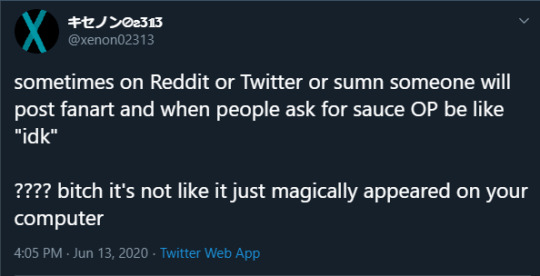
Imgur
Imgur isn’t that bad compared to the rest of these, but it’s a common one that people link to when asked for the source of whatever they’ve shared on Twitter or Reddit or whatever.
Amino Apps
Amino Apps is a strange case. I don’t know much about it since I’ve never used it, but from what I do know it seems similar to Reddit in that there are numerous communities for different niches. That said, judging from the way it clogs up Google image search results, I doubt OC art is posted there often.
YouTube
Now, you may be thinking, “How does a video site rip off others’ art?”. The answer is uploads of soundtracks. Look for any OST from a video game or anime on YouTube and the picture used for the video will likely be some fan art by a Japanese Pixiv artist, usually one that forbids reposts of their work. Not only that, but if the uploader did bother to add the source in the description, it’s usually not even a link to the actual source, more likely a link to Zerochan or Pinterest or something. Now take into account that some of these videos get millions of views. Imagine working hard on something, and some numbnuts takes it, slaps some music onto it, uploads it to YouTube, and gets millions of views while you get next to nothing in comparison.
Exhibit A
Exhibit B (re-upload; original had nearly 40 million views before it was copyright claimed)
Exhibit C
and many many others
Pinterest
Alright, this is the big one. When Pinterest isn’t giving recipes or wardrobe ideas to suburban white moms, it’s clogging up Google reverse image search, punishing anyone who just wanted to find the source of some cute fan art. I feel like this meme by ZebitasMartinexSi on Facebook sums it up:

For example, this piece of Legend of Zelda art by Twitter artist @_nomeri_ (I’ll just link to it, since it would be hypocritical of me to embed the image even though @_nomeri_’s bio warns people not to repost their art). Good art, right? Well, if you right-click and hit “Search Google for image”...

...yeah. Pinterest is a plague. It thrives on theft. Even worse is when someone will post fan art on Twitter/Tumblr/Reddit/etc. and have the nerve to say “IDK the source I found it on Pinterest ^_^”. Or worse yet, they link to Pinterest saying it’s the source.
Instagram
While many other sites rag on Instagram for its reposting of memes, it’s no better when it comes to reposting fan art, especially from Pixiv. I’ve seen lots of stolen pieces with fan fictions written in the description. Personally, if I were an artist, I’d rethink my career choice if I saw my art reposted on Instagram with a half-assed fanfic under it, so I don’t blame Japanese artists who close their Pixiv accounts after seeing that. But that doesn’t mean we shouldn’t try to prevent it from happening in the first place.
DeviantArt
DeviantArt is more “renowned” across the web for its niche circles of bizarre fetish art, but in its defence, there are some legitimately good pieces on there. If you do find a good one though, try checking to see if all of the uploader’s pieces have a similar overall art style, because if not, that’s a sure sign of someone passing off some Pixiv user’s art as their own, which is unfortunately fairly common on DeviantArt.
9Gag
Not a whole lot to say about 9Gag. I mean, it does contribute to reposting of art, but nothing really separates it from the others on this list, aside from its watermarks. At least the watermark gives away the fact that something was reposted.
Know Your Meme
You know that Zelda pic by @_nomeri_ I was talking about earlier? Well, to add insult to injury, it became an object-labelling meme.

Imagine putting hours into something and politely asking others not to repost it, only to find that some nincompoops on r/DankMemes made it into an object-labelling meme.
But this isn’t KYM’s fault, per se. Know Your Meme only documents memes; they do not create them. However, as someone who regularly browses the Know Your Meme image galleries, I can say that the image gallery has essentially become Know Your Fan Art (unlawfully reposted fan art, that is).
Redbubble
There’s an NSFW artist I follow on Twitter by the name of Nico-Mo. A while ago, his Pixiv account was suspended, and there were numerous pictures on there that he had not uploaded to his Twitter or DeviantArt, so I found a mirror of one of those pieces on Gelbooru and reverse-image searched in hopes of finding it on his Twitter. No such luck. What came up instead was a .png of the piece made into a sticker being sold on Redbubble. In fact, that’s one of the major reasons why artists disapprove of their art being reposted, as it may find its way onto a sticker or a T-shirt being sold as merch without the original artist giving consent nor the artist receiving so much as a single nickel.
Facebook
Surprisingly, I think Facebook is one of the least offending sites on this list. Still worth mentioning, though.
Funnyjunk
Like Imgur, Funnyjunk isn’t that bad compared to some of the rest of these, but this exchange in the comments of a repost of an MHA artist that deleted their account (not hard to see why considering people straight-up ignored the big-ass watermark at the bottom) is proof enough of western social media’s flippant attitude towards ruining online artists’ careers.
Aggregator imageboards such as Yande.re, Konachan, Danbooru, Gelbooru, Rule34, SankakuComplex, Zerochan, etc.
I don’t think I need to explain these. But like Imgur, these are what most people link to when asked for source instead of bothering to find the original post.

We Heart It
I don’t know much about “We Heart It”, but it seems to be a “Pinterest Lite” considering it clogs up image search almost as much as Pinterest does.
iFunny
Basically the same as 9Gag, in the sense that its watermarks are a dead giveaway.

4chan
I’m not sure if 4chan really “counts” among these, as it’s a chat board where nearly everything is impermanent anyway. However, I was once on an NSFW subreddit where one submitter used a 4chan thread to get Patreon-exclusive material from an artist to upload to the sub (even though one of the rules of the sub was “no paywall content”), so that alone earns 4chan its spot on this list.
Tumblr
Yes, not even Tumblr is innocent. Although I’m sure you knew that. Similar to what I said about Twitter, look up any blog named after a fictional character and it’ll likely be chock-full of unsourced fan art.
“Why is this even important?”
Because if an artist sees that their work is being reposted, depending on the artist, they may delete the original post when they wouldn’t have to if people had just respected their wishes. Now, if an artist wants their works gone from the internet for other personal reasons, that’s up to them and we should respect them for it. But artists taking down their works due to mass reposting is 100% preventable, which is why it’s sad. If you don’t respect an artist, they won’t create art. Simple as that.
“Why do you care so much?”
Eh, I’m just weird like that. It just ticks me off when anything online, whether it be art, or a video, or whatever, is lost. In my opinion, nothing hurts more than clicking a Pixiv link on an imageboard and being greeted with “The work was deleted or the ID does not exist.”.

“But lots of western artists forbid reposting of their art too!”
Indeed, that is correct. But while many artists of every nationality and culture frown upon reproduction of their work, it seems only western social media is responsible for reposting art in the first place. I mean, why else do you think Japanese artists are saying “Reprint is prohibited” in English when the rest of their bio is in Japanese? Because English-speakers are the ones reposting.
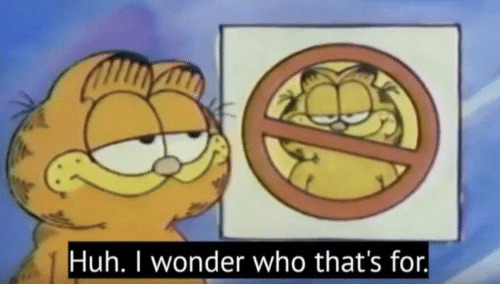
“But exposure can help an artist!”
Yeah, that’s true...
...but “exposure” doesn’t mean much if those “exposed” to one’s work don’t know or care who it came from.
And if you need even more reasons, look no further than these posts about the same topic by other blogs:
https://cranberrywitch.tumblr.com/post/143456002228/stop-reposting-art-from-japanese-artists
https://thegospelofnagisa.tumblr.com/post/143308182398
https://edendaphne.tumblr.com/post/163117317030/ive-been-wanting-to-make-this-educational-cheat
https://marklightgreatsword.tumblr.com/post/190056977650/discourage-art-theft-in-fandom-in-2020-dont
https://letusrespectpixivartistconsent.tumblr.com/post/92189994896/why-is-this-important
also, not to self-promote but I made a thread on Twitter on this topic about a month ago that you can check out here.
That’s all.
posted Jun 14; last edit Jun 21
#art theft#pinterest#rant#essay...?#soapbox#pixiv#twitter#tumblr#respect artists#deviantart#instagram#weheartit#aminoapps#know your meme#reddit#western#japanese#art#artists#imageboards
1 note
·
View note